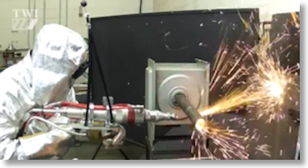Home
A comprehensive resource for safe and responsible laser use
UK: Handheld (industrial) laser easily cuts through metal
A UK firm, TWI Ltd., has made a handheld laser that can easily cut through plate metal up to 10 mm thick. In 2010, the Cambridge company developed an industrial robot with a laser cutter head, used to decommission nuclear reactors. To create the handheld version, they removed the head from the robot, and added a pistol stock with trigger to turn the beam on and off.

The device came to public attention September 28 2013 when gadget blog Gizmodo published an article entitled Holy Crap, This Real-Life Laser Rifle Cuts Through Metal Like Nothing. The article links to TWI’s YouTube video of the laser in action.
From the video, it appears that the laser light and compressed air (to blow away molten material) comes from a separate device, and is delivered through the handheld laser head assembly. Also, the laser head is partially supported in a sling; it is not known if this is for weight support, to help with aiming, or both.
The person operating the laser wears a protective reflective suit and goggles.
The laser beam is in the invisible infrared portion of the spectrum, at a wavelength of 1000 nanometers. [For comparison, visible light is roughly from 710 nm (deep red) to 400 nm (violet)]. The divergence is unknown, so the eye hazard range (Nominal Ocular Hazard Distance) of the laser cannot be calculated. Because the beam is invisible, It would not be a visual interference hazard to aircraft or drivers.
Video from TWI at YouTube. TWI’s has a case study and a webpage about this application. Thanks to Greg Makhov for bringing the Gizmodo story to our attention.
The person operating the laser wears a protective reflective suit and goggles.
The laser beam is in the invisible infrared portion of the spectrum, at a wavelength of 1000 nanometers. [For comparison, visible light is roughly from 710 nm (deep red) to 400 nm (violet)]. The divergence is unknown, so the eye hazard range (Nominal Ocular Hazard Distance) of the laser cannot be calculated. Because the beam is invisible, It would not be a visual interference hazard to aircraft or drivers.
Video from TWI at YouTube. TWI’s has a case study and a webpage about this application. Thanks to Greg Makhov for bringing the Gizmodo story to our attention.